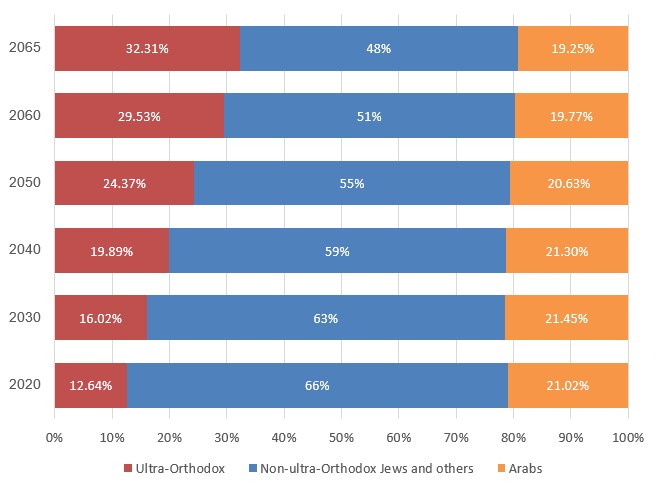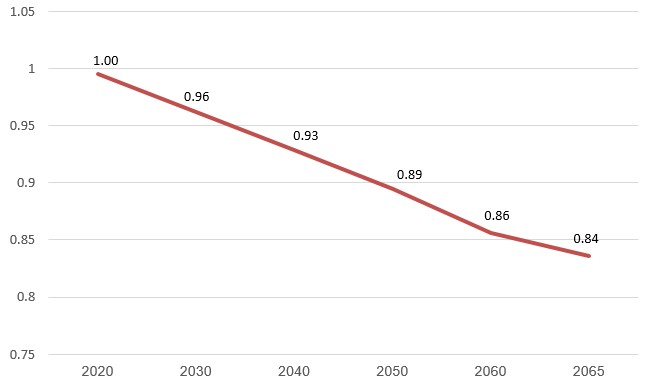Publications
INSS Insight No. 1704, March 30, 2023
Israel’s new government faces many important challenges that may well shape the face of the state for years to come. One of the existential challenges facing the country is integrating the ultra-Orthodox population into the fabric of society and the economy. This is not only vital today, but it is crucial when looking ahead. The impressive level of economic growth that Israel recorded in the past 20 years, which led to a sharp increase in the quality of life, is now in danger because the positive trends clash with demographic forecasts. The coalition agreements and the proposed budget not only fail to address these dangers, but to a large extent, they exacerbate them. It seems that even without the dire potential economic consequences of the proposed changes to the judicial system, Israel is closer than ever to economic stagnation.
The Israeli economy has shown impressive growth over the past 20 years. This follows a severe economic recession in the early 2000s, caused by a combination of the second intifada and the ramifications of the dot-com crash. In that period, the Israeli government, under Prime Minister Ariel Sharon and then-Finance Minister Benjamin Netanyahu, implemented a series of economic reforms designed to stimulate growth. Starting in 2005, the economic reforms and the stability on the security front also manifested themselves in an increase in GDP – so much so, that in 2010, Israel was accepted as a member of the Organization for Economic Cooperation and Development (OECD). Israel’s economy has continued to grow impressively over the past decade, and according to the World Bank, in 2021 Israel’s GDP per capita, in terms of purchasing power parity, was almost double what it had been at the start of this century.
Some of the main components of the reforms passed in 2003 were attractive financial incentives, designed to encourage people to move from welfare subsistence to the workforce. These included cuts to government benefits, in part by tightening the conditions for receiving welfare payments. This policy primarily succeeded in encouraging ultra-Orthodox women to join the workforce and led to the creation of educational frameworks for ultra-Orthodox women, which offer training in fields dictated by the labor market. Dozens of girls’ seminaries and colleges were established – focusing on education, teacher training, accounting, law, and, more recently, computer programming. As a result, and coupled with adaptations in workplaces, the employment rate among ultra-Orthodox women increased significantly – from around 50 percent in 2003 to a high of 83 percent in the last quarter of 2021. This is similar to the employment rate among non-ultra-Orthodox Jewish women.
At the same time, and despite the improvement in the employment rate, there are still significant differences in quality of employment between ultra-Orthodox women and other Jewish women. Ultra-Orthodox women tend to work part time and in industries typified by relatively low pay (such as education and caregiving). As a result, ultra-Orthodox women earn around 20 percent less on average for one hour of work than other Jewish women.
The situation among ultra-Orthodox men is even worse. For various reasons – some cultural and some societal – the incentives included in the 2003 reforms did not manage to integrate ultra-Orthodox men into the workforce in the same way. In contrast to ultra-Orthodox women, the ultra-Orthodox education system for boys focuses on religious studies and neglects the core curriculum. Moreover, ultra-Orthodox society encourages graduates of the ultra-Orthodox education system to focus on Torah study at the expense of employment and higher education. Consequently, there are not many educational institutions offering advanced degrees for ultra-Orthodox men, and in turn, ultra-Orthodox men find it harder to enroll in institutions of higher learning and integrate into the workforce in more prestigious professions. In 2003, the employment rate among ultra-Orthodox men was around 35 percent; it climbed to just 53 percent in 2022 – far from the employment rate among other Jewish men.
Data provided by the Israeli Employment Service accurately depicts the gaps in GDP per capita between the various sectors of Israeli society. According to these figures, GDP per capita in the Jewish, non-ultra-Orthodox sector is three times higher than in the non-ultra-Orthodox sector, and slightly less than three times higher than the Arab sector (Table 1). GDP per capita in the ultra-Orthodox and Arab sectors is even lower than the average GDP per capita across the Middle East, which stands at around $19,000 a year. In contract, GDP per capita among Israeli Jews who are not ultra-Orthodox is among the highest in the Western world.
Table 1: GDP Per Capita According to Sector (thousands of dollars, 2017)

There are several reasons for these gaps. Ultra-Orthodox men are not integrated into the economy to the same extent as the rest of the population, and since 2015, the employment rate among that sector has fluctuated around the 50 percent mark, compared to 85 percent among other Jewish men. In addition, a study by the Bank of Israel in 2019 found that their workforce productivity was around 60 percent lower than among Jewish men who are not ultra-Orthodox, and the workforce productivity of ultra-Orthodox women was around 40 percent lower than among other Jewish women. One of the key reasons behind these gaps is that ultra-Orthodox schools do not teach the core curriculum and do not provide an education suitable for the modern labor market. The ultra-Orthodox education system operates as an entirely separate entity, almost without supervision from the Education Ministry. Ultra-Orthodox boys only study core subjects at a very superficial level – if at all – and do not acquire the basic tools needed to enter the labor market or higher education. Boys enrolled in elementary schools in the ultra-Orthodox sector achieve significantly poorer grades than the national average on standardized fifth grade mathematics tests, with over 70 percent of them receiving a failing grade of less than 55 percent. Only around 20 percent of girls and 4 percent of boys in the ultra-Orthodox sector qualify for a high school matriculation certificate.
Efforts to improve the situation have consistently been stymied by fierce opposition from the ultra-Orthodox leadership. In 2014, then-Education Minister Shai Piron set up a state-run ultra-Orthodox education stream, which combined Torah studies with a full matriculation curriculum. However, the ultra-Orthodox leadership at the time objected to the plan and has continued to oppose the integration of ultra-Orthodox students in the program – despite the increased demand from within ultra-Orthodox society. As a result, fewer than 5 percent of ultra-Orthodox students are part of the program. Not surprisingly, then, the situation has only deteriorated. A study conducted in 2022 by the Israel Democracy Institute found that over the past few decades, there has been a marked decline in English studies in the ultra-Orthodox education system. While 54 percent of male graduates of the ultra-Orthodox education system over the age of 45 studied English, only 18 percent of those between 18 and 24 have done so.
It is not surprising, then, that ultra-Orthodox individuals have a hard time finding work in prestigious fields. The hi-tech sector provides a microcosm of the problem. The industry is characterized by an interesting and challenging working environment – and a very lucrative one. Hi-tech comprises more than half of Israel’s exports ($67 billion in 2021) and was responsible for 45 percent of total economic growth between 2017 and 2021. According to a 2022 report by the Ministry of Economy and Industry, among people between 25 and 35 who work in hi-tech, only 2.5 percent of the men and 4.7 percent of the women are part of the ultra-Orthodox sector. Despite the efforts and resources that have been invested, it seems that the ability to close fundamental education gaps at later ages is very limited. Without a fundamental reform of the ultra-Orthodox education system, this population will not be able to integrate into more prestigious industries.
The problem of workforce productivity and low integration rates in ultra-Orthodox society becomes critical in light of demographic forecasts (Figure 1). With a birthrate that fluctuates around seven children per woman, the proportion of the ultra-Orthodox population in Israel is expected to climb significantly over time. While the ultra-Orthodox currently make up around 13 percent of the general population, within 45 years they are expected to constitute up to one third of Israel’s population.
Figure 1: Israel’s population forecast over time, by population group

Even beyond the problem of overcrowding that would be created by an annual population increase of around 2 percent, the rise in the proportion of the ultra-Orthodox population also creates difficult economic challenges. Figure 2 combines the gaps in workforce productivity for various sectors (Table 1) and the forecast demographic changes for each sector (Figure 1), to forecast Israel’s future GDP per capita (with 2020 as the reference point).
Figure 2: GDP over time as a function of the demographic makeup of the Israeli population (relative to GDP per capita in 2020)

The figure clearly shows that the Israeli economy is hurtling toward a substantial decrease in GDP per capita. If there is no significant overhaul of the ultra-Orthodox education system, GDP per capita in Israel will shrink by 5 percent at the start of the next decade, 10 percent by 2050, and 15 percent by the start of 2060s. These forecasts are in comparison to Israel’s predicted GDP per capita if the current distribution of the population remained unchanged. This worrying assessment is, in fact, an underestimate of the damage to GDP per capita in light of the current trends in the ultra-Orthodox education system, and the expected response of other sectors to future economic stagnation (such as the transfer of some business activities overseas and the establishment of new companies in other countries). These processes will only be exacerbated by the forecasted economic implications of the proposed judicial overhaul – all of which are gloomy. According to the Finance Ministry’s chief economist, and based on reports from international credit rating agencies, the judicial revolution will lead to a drop of 0.8 percent in the growth of GDP.
Plainly put, the Israeli economy is on an unsustainable trajectory and there must be a sharp change of course when it comes to national policy vis-à-vis ultra-Orthodox society if Israel wants to continue the positive economic trends of recent years. Unfortunately, instead of spearheading a change in direction, the state budget recently approved by the government only serves to accelerate these negative processes. The coalition agreements that Likud signed with the ultra-Orthodox parties may provide some short-term political stability, but they threaten to undermine the State of Israel’s economy in the future. The upcoming budget will increase funding for ultra-Orthodox educational institutions by 60 percent (an addition of 2.5 billion shekels), without obligating them to teach the core curriculum. As a result, today’s students will, in the next few years, be in a dire starting position with regard to the employment opportunities in general, and in high productivity sectors in particular.
This worrisome forecast is not inescapable. To avert it, Israel must examine itself closely and adopt courageous policies to change the destructive path that ultra-Orthodox society – and the Israeli economy – are on. These demographic forecasts are a national challenge of the first order. The security challenges facing the State of Israel oblige it to have a strong and innovative military, with a clear technological advantage over our enemies. A stagnant economy can provide nothing more than an army capably of providing merely stagnant security.



